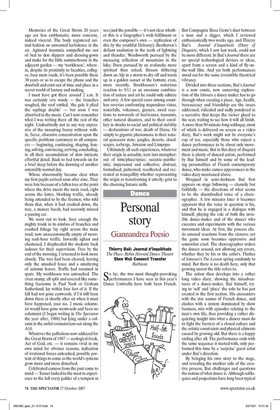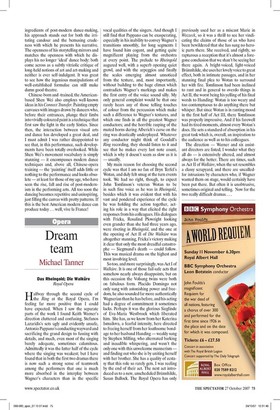Personal story
Giannandrea Poesio Thierry Bee: Journal d'inquietude The Place: Robin Howard Dance Theatre Shen Wei: Connect Transfer Barbican C o far, the two most thought-provoking L./performances I have seen in this year's Dance Umbrella have both been French.
But Compagnie Beau Geste's duet between a man and a digger, which I reviewed enthusiastically two weeks ago, and Thierry Bae's Journal d'inquietude (Diary of Disquiet), which I saw last week, could not be more different. In Bae's Journal there are no special technological devices or ideas, apart from a screen and a kind of fly-onthe-wall film. And yet both performances stood out for the same irresistible theatrical vibrancy.
Divided into three sections, Bae's Journal is a now comic, now unnerving exploration of the labours a dance-maker has to go through when creating a piece. Age, health, bureaucracy and friendship are the issues addressed, ridiculed and sadly pondered in a narrative that keeps the viewer glued to the seat, waiting to see how it will all finish. A more than 90-minute-long soliloquy, most of which is delivered on screen as a video diary, Bae's work might not be everyone's cup of tea, especially those who expect a dance performance to be about only movement and music. But in this diary of disquiet there is plenty of danced action, performed by Bae himself and by some of the leading personalities of French contemporary dance, who make cameo appearances in the video diary mentioned above.
Wrapped in semi-darkness Bae first appears on stage following — clumsily but faithfully — the directions of what seems to be the disembodied voice of a choreographer. A few minutes later it becomes apparent that the voice in question is his, and that he is engaged in a dialogue with himself, playing the role of both the invisible dance-maker and of the dancer who executes and experiments with the various movement ideas. At first, the process elicits amused reactions from the viewers; yet the game soon becomes oppressive and somewhat cruel. The choreographer orders the dancer around, not allowing any errors, whether they be his or the artist's. Flashes of Ionesco's The Lesson spring randomly to mind. But there is no death here, only that growing unrest the title refers to.
The action then develops into a rather long video diary, showing the misadventures of a dance-maker, Bae himself, trying to 'sell' and 'place' the solo he has just created in the first section. His encounters with the star names of French dance, and clashes with a system dominated by show business, mix with episodes relating to the man's own life, thus providing a rather disquieting insight into what a dancer must do to fight the barriers of a closed culture and the artistic constraints and physical ailments caused by growing old. But there is a happy ending after all. The performance ends with the same sequence it started with, only performed this time by a 'surprise' guest artist under Bae's direction.
By bringing his own story to the stage, and revealing the murkier side of the creative process, Bae challenges and questions the notion of what dance is. Although soliloquies and projections have long been typical ingredients of post-modern dance-making, his approach stands out for both the irritating candour and the bemusing crudeness with which he presents his narrative. The openness of his storytelling mirrors and matches the openness with which he displays his no longer 'ideal' dance body: both come across as a subtly vitriolic critique of long-held notions of art and art-making and neither is ever self-indulgent. It was great to see how the ingenious manipulations of well-established formulae can still make damn good theatre.
Chinese-born and -trained, the Americanbased Shen Wei also employs well-known ideas in his Connect Transfer. Painting empty canvases with images drawn by dancers who, before their entrances, plunge their limbs into vividly coloured paint is a technique that first saw the light in the early Sixties. Since then, the interaction between visual arts and dance has developed a great deal, and I must admit I was rather disappointed to see that, in this performance, such developments have been totally overlooked. While Shen Wei's movement vocabulary is simply stunning — it encompasses modern dance techniques and, above all, Chinese-opera training — the 'painting' itself adds little or nothing to the performance and looks obsolete — at least for those of my age, who have seen the rise, fall and rise of post-modernism in the performing arts. All too soon the dancing becomes repetitive and uninspiring, just filling the canvas with pretty patterns. If this is the best American modern dance can produce today. ... well, vive la France!



































































 Previous page
Previous page